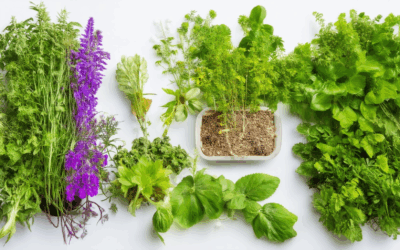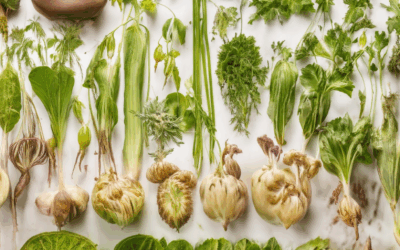Gardening has long been recognized as a powerful tool for fostering biodiversity, offering a haven for wildlife and contributing positively to the health of our planet. By thoughtfully designing and maintaining gardens, individuals can play a crucial role in supporting local ecosystems, enhancing soil health, and providing essential habitats for pollinators and other creatures. Whether through vegetable gardening or landscape design, the integration of diverse plant species and thoughtful practices can significantly boost biodiversity while benefiting both humans and nature. This comprehensive guide explores the intricate relationship between gardening and biodiversity, delving into strategies for creating thriving ecosystems, selecting plants that promote biodiversity, and designing spaces that inspire and sustain life. From understanding the role of native plants to envisioning creative designs, this resource equips readers with the knowledge and tools needed to cultivate a biodiverse backyard habitat, ultimately contributing to a healthier planet for future generations.
Key Takeaways
– Assess soil health and choose native plants to support biodiversity.
– Implement water-wise practices like rainwater harvesting and drip irrigation.
– Create habitats with ponds, birdbaths, feeders, and nesting boxes.
– Design planting zones with annuals and perennials for continuous color and support.
– Provide food sources through insect hotels and seed bombs.
– Regularly maintain and monitor to keep the habitat thriving.
- Diverse lawns attract pollinators, birds, and small mammals.
- Use native plants and minimize pesticides for better biodiversity.
- Allow some weeds to enhance ecosystem health.
- Add features like rock piles or birdhouses to encourage wildlife interaction.
- Evaluate property for natural shelters and sunlight conditions.
- Install water sources like bird baths or small ponds.
- Plant native vegetation to attract specific species.
- Add shelters such as nest boxes and deadwood habitats.
- Encourage insects with wood piles and improve soil health with compost.
- Provide consistent water sources and use natural mulch.
- Monitor and adjust the habitat as needed for wildlife benefit.
- Maintain regularly to ensure functionality and welcoming environment.
How Does a Garden Help Biodiversity?
A garden can significantly contribute to biodiversity by creating habitats for various species. Here’s how:
- Supports Native Plants: Planting native vegetation enhances local ecosystems, providing food and shelter for native animals and insects. Native plants are adapted to local conditions, making them more resilient and requiring less maintenance.
- Pollinator Habitats: Gardens filled with flowers attract pollinators like bees and butterflies, which are crucial for ecosystem health. These pollinators help in the reproduction of many plants, including food crops.
- Wildlife Shelter: Gardens can serve as shelters for birds, small mammals, and reptiles. Bird feeders, water features, and dense shrubs provide safe spaces and food sources for wildlife.
- Carbon Sequestration: Vegetation in gardens absorbs carbon dioxide, helping to mitigate climate change and improve air quality.
- Connects Ecosystems: Gardens act as corridors that connect fragmented habitats, facilitating the movement of animals and the dispersal of seeds.
By adopting sustainable gardening practices, such as using organic fertilizers and minimizing chemical use, gardeners can further enhance biodiversity. Old Seed offers valuable resources for creating eco-friendly gardens that support local wildlife.
Other notable resources include Sustainable Gardening Hub and EcoGarden Guides , both of which provide comprehensive guides for gardeners seeking to promote biodiversity.
What Plants Increase Biodiversity?
Biodiversity refers to the variety of life forms on Earth, including plants, animals, fungi, and microorganisms. Plants play a crucial role in supporting biodiversity by providing habitats, food, and shelter for countless species. Here are some plants that significantly contribute to increasing biodiversity:
- Native Plants: Native plants are adapted to local conditions and provide essential food and shelter for native wildlife. They help maintain ecosystem balance and support pollinators like bees and butterflies.
- Pollinator-Friendly Plants: Flowers like sunflowers, lavender, and wildflowers attract pollinators such as bees, butterflies, and birds, which are vital for biodiversity.
- Nitrogen-Fixing Plants: Plants like legumes (e.g., clover, peas) and certain trees fix nitrogen from the air, enriching the soil and benefiting nearby ecosystems.
- Soil Improvers: Cover crops like comfrey and clover improve soil health, providing nutrients and organic matter that support diverse plant and animal life.
- Shrub and Bushes: Shrubs such as elderberry and currant provide berries that attract birds and mammals, while their dense growth supports insects and small animals.
- Herbaceous Perennials: Plants like echinacea (coneflower) and daylilies offer nectar and shelter to pollinators and other wildlife, enhancing biodiversity.
- Grasses and Grasslands: Tall grasses and grassland plants create habitats for grassland birds, insects, and small mammals, supporting a rich ecosystem.
- Water Plants: Aquatic plants like watercress and duckweed stabilize water environments, providing shelter for aquatic organisms and supporting wetland biodiversity.
- Food Plants: Fruit-bearing plants like apples, berries, and figs attract fruit-eating birds and mammals, aiding in seed dispersal and biodiversity.
- Endangered Species Plants: Protecting and planting rare or endangered species ensures genetic diversity and supports unique ecosystems dependent on these plants.
Incorporating these plants into your environment can create a haven for biodiversity, attracting wildlife and contributing to a healthier ecosystem. By planting a variety of these species, you help sustain the delicate balance of life on Earth.
Learn more about sustainable gardening practices at Old Seed .
How Does Planting Help Biodiversity?
Planting plays a vital role in supporting biodiversity, contributing to ecosystem health, and ensuring the survival of various species. Here’s how planting can positively impact biodiversity:
Supports Local Ecosystems
By planting native vegetation, you provide natural habitats for local flora and fauna. Native plants are well-adapted to their environments, offering food, shelter, and nesting grounds for birds, insects, and other animals.
- Native plants attract pollinators like bees and butterflies, which are crucial for ecosystem functioning.
- They provide food and shelter for small mammals, reptiles, and amphibians.
- Natural habitats reduce the risk of extinction for endangered species.
Connects Fragmented Landscapes
Plants act as corridors that connect isolated habitats, allowing species to move safely between regions. This connectivity is essential for maintaining genetic diversity and ensuring populations remain viable.
- Planting along roads, railways, and waterways helps bridge gaps between natural areas.
- This connectivity supports migration and gene flow, which are critical for population health.
Restores Soil Health
Healthy soil is the foundation of biodiversity. Trees and other plants improve soil structure, prevent erosion, and enrich the soil with organic matter, benefiting both plant and animal life.
- Improved soil health supports nutrient-rich environments for growing plants and microorganisms.
- Strong root systems stabilize soil and prevent landslides, protecting both plants and animals.
Provides Food and Shelter
Plants offer sustenance and protection for diverse organisms. Fruit-bearing plants feed birds and animals, while dense shrubs and bushes provide hiding spots for small creatures.
- Fruit trees and berry bushes attract birds and wildlife, aiding in seed dispersal and nutrition.
- Vegetation along streams and ponds supports aquatic life, maintaining water quality and providing habitats.
Reduces Pollution and Climate Impact
Trees and plants absorb greenhouse gases, helping combat climate change. They also filter pollutants from the air, improving water quality and reducing the risks to biodiversity.
- Carbon sequestration through planting reduces the greenhouse effect and mitigates global warming.
- Plants act as natural filters, removing toxins from the environment and purifying the air.
Creates Refuges for Species
Certain plants, like mangroves and salt marshes, serve as critical habitats for unique species. Protecting these plants ensures the survival of specialized organisms.
- Mangrove forests and wetland plants provide breeding and feeding grounds for many species.
- These areas act as buffers against coastal erosion and storms, safeguarding biodiversity hotspots.
Promotes Biodiversity Through Community Efforts
Community-led planting initiatives, such as urban green spaces and reforestation projects, engage people in preserving biodiversity. These efforts foster stewardship and ensure long-term environmental health.
- Urban gardens and green roofs provide habitats for city-dwelling wildlife.
- Reforestation projects restore ecosystems, benefiting both local and migratory species.
By planting thoughtfully and sustainably, we contribute to a healthier planet, ensuring the survival and thriving of biodiversity for generations to come. To learn more about effective planting practices and how you can get involved, visit The Nature Conservancy or World Wildlife Fund .
How to Create a Biodiverse Backyard
To create a biodiverse backyard, follow these organized steps for a thriving ecosystem:
1. Plan Your Backyard Habitat
- Assess Soil Health : Test your soil’s pH levels and fertility. Healthy soil supports diverse plant growth.
- Choose Native Plants : Select plants suited for your region’s climate and soil conditions to attract local wildlife.
2. Implement Water-Wise Practices
- Install Rainwater Harvesting Systems : Capture rainwater for irrigation, reducing reliance on municipal water supplies.
- Set Up Drip Irrigation : Efficiently water plants with minimal waste, ideal for arid climates.
3. Create Habitat Features
- Build a Pond or Birdbath : Provide water sources for amphibians and birds, ensuring proper permits are obtained.
- Add Bird Feeders and Nesting Boxes : Attract feathered friends with these simple additions available from local stores or online shops.
4. Design Planting Zones
- Sunlight Optimization : Grow sun-loving plants in full sun and shade-tolerant varieties in shaded areas.
- Mix Annuals and Perennials : Ensure seasonal color and continuity with a mix of flowers that bloom at different times.
5. Provide Food and Water Sources
- Install Insect Hotels : Create habitats from wood or recycled materials to shelter beneficial insects.
- Sow Wild Areas : Allow natural areas to flourish, supporting rare or endangered species.
- Make Seed Bombs : Scatter these balls of seeds to aid in dispersal and germination.
6. Maintain and Monitor
- Regular Weed Control : Keep invasive species in check to preserve biodiversity.
- Divide Perennials : Every few years, split perennials to maintain a vigorous, attractive garden.
- Engage Neighbors : Consider forming a community garden to share resources and knowledge.
By following these steps, you’ll create a sanctuary for wildlife and enhance your outdoor space. Remember, biodiversity benefits both the environment and your family, fostering a sustainable and beautiful backyard ecosystem.
Are Lawns Good for Biodiversity?
A well-maintained lawn can play a crucial role in supporting local biodiversity, providing habitat and food sources for a variety of wildlife. While conventional lawns may not seem eco-friendly at first glance, their ability to foster biodiversity often surpasses expectations when managed thoughtfully.
Overview of Lawn Benefits
Natural, diverse lawns offer essential support for local flora and fauna by creating habitats that preserve ecological balance. These environments allow native plants to thrive, providing food and shelter for insects, birds, and small mammals. Studies have shown that lawns managed with sustainability in mind can support a wider range of species compared to heavily treated, mono-cultural lawns.
Specific Wildlife Benefits
- Pollinators:** Native flowers in lawns attract bees, butterflies, and other pollinators, which are critical for ecosystem health and crop production.
- Birds:** Many bird species rely on lawns for food and nesting material. Birds like robins, sparrows, and blue jays frequently visit lawns for insects and seeds.
- Small Mammals:** Rabbits, moles, and voles often find shelter and food in undisturbed lawn areas, particularly those with dense vegetation.
- Insects:** Lawns serve as habitats for beneficial insects like ladybugs and earthworms, which help control pests and improve soil health.
Considerations and Limitations
While lawns can support biodiversity, certain factors can negatively impact their ecological value. Overuse of pesticides and fertilizers can harm beneficial organisms and reduce biodiversity. Additionally, invasive species like dandelions and clover can outcompete native plants, diminishing the lawn’s biodiversity benefits. However, these issues can be mitigated through organic maintenance practices and careful planting.
Tips for Homeowners
- Use Native Plants:** Incorporate native grasses and wildflowers into your lawn to attract pollinators and other wildlife.
- Minimize Pesticide Use:** Opt for organic alternatives like composting or natural predators to control pests.
- Create Habitat Features:** Add rock piles, logs, or birdhouses to your property to encourage wildlife interaction with your lawn area.
- Allow Some Weeds:** Diverse plant species contribute to a healthier ecosystem, so consider letting some weeds grow naturally.
By adopting sustainable practices, homeowners can enhance their lawns’ role in supporting local biodiversity while enjoying a beautiful, ecologically conscious space. Old Seed offers valuable resources for learning more about heirloom gardening and sustainable practices that can further benefit your lawn and local wildlife.
Learn more about sustainable gardening practices at Old Seed
How to Turn Your Yard Into a Wildlife Habitat
To transform your yard into a thriving wildlife habitat, follow these organized steps:
- Assess Your Property: Identify areas that offer natural shelter, such as dense shrubs, trees, or rock piles, and evaluate sunlight exposure, water sources, and existing vegetation.
- Install Water Sources: Create a bird bath using a shallow basin or a small pond. Maintain it regularly to ensure it remains clean and free from debris.
- Plant Native Vegetation: Select plants native to your region, such as milkweed for butterflies, sunflowers for pollinators, and berries like strawberries for birds. Consider planting perennials like coneflowers and lavender.
- Add Shelter Opportunities: Construct nest boxes for birds, such as bluebird houses, and leave dead trees or logs as natural shelters. Place these in shaded areas to provide relief from harsh sunlight.
- Encourage Insect Habitats: Leave piles of wood or branches in shaded spots to attract insects, which serve as food for frogs and other small creatures.
- Improve Soil Health: Use compost, especially from your vegetable garden, to enrich the soil. This supports plant growth and microorganisms essential for a healthy ecosystem.
- Provide Year-Round Water Sources: Ensure consistent access to water with a shallow bowl or small pond, maintaining cleanliness to prevent mosquito breeding.
- Use Natural Mulch: Opt for organic mulches like straw or wood chips to retain moisture, suppress weeds, and provide habitats for earthworms and other organisms.
- Monitor and Adjust: Regularly observe the yard to identify wildlife visitors and adjust the habitat as needed, such as pruning plants or adding more shelter spaces.
- Maintain Regularly: Schedule checks for the bird bath and ongoing maintenance of plants and structures to ensure the habitat remains welcoming and functional.
By focusing on native plants, natural features, and minimal intervention, you’ll create a sanctuary that supports diverse wildlife, fostering a balanced and thriving ecosystem in your yard.








0 Comments